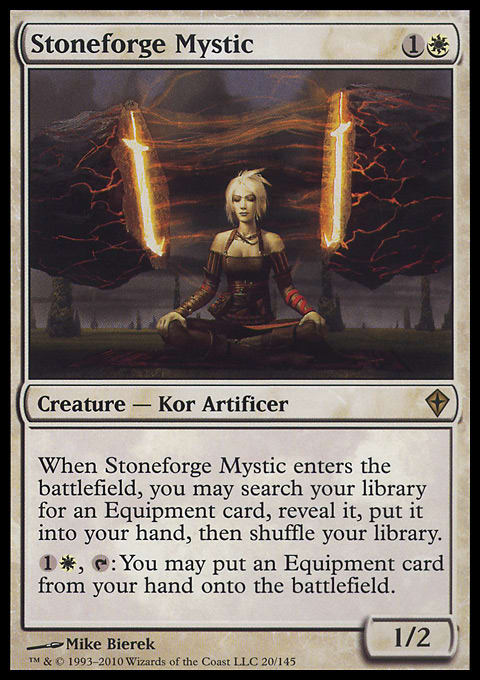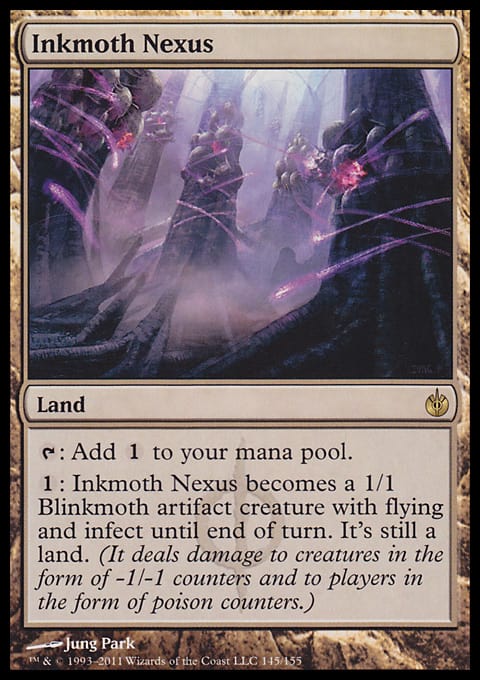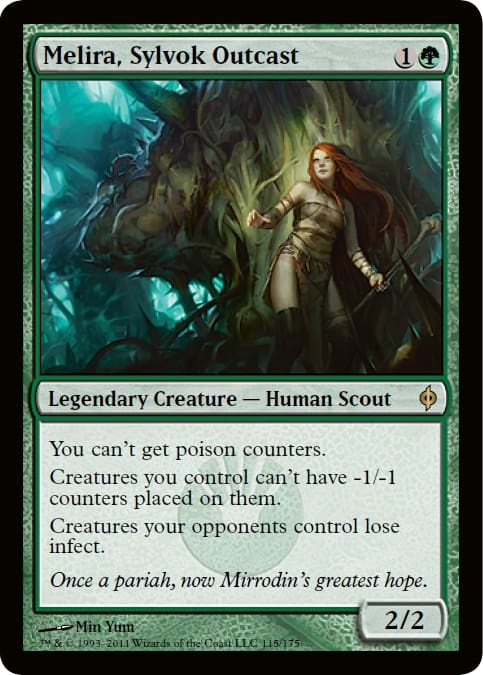Last week, we took a look at the origin of the Event Decks, a Standard-ready product line that ran from 2011 until last year, before, at last, the plug was pulled. Wizards made a number of changes to the Event Deck over the course of its relatively brief life, and 2011 was a seminal year in the product’s development. The inaugural entries hadn’t made a huge impact, but for New Phyrexia’s pair of offerings, Wizards was taking a page from a very different playbook.
Year: 2011
Set: New Phyrexia
Deck: War of Attrition
Rares: Bonehoard, Kemba, Kha Regent, Mirran Crusader, Puresteel Paladin, Stoneforge Mystic (x2), Sword of Vengeance
War of Attrition ? New Phyrexia Event Deck | Wizards of the Coast
- Creatures (23)
- 1 Kemba, Kha Regent
- 1 Mirran Crusader
- 1 Puresteel Paladin
- 2 Kor Duelist
- 2 Stoneforge Mystic
- 4 Elite Vanguard
- 4 Leonin Relic-Warder
- 4 Leonin Skyhunter
- 4 Porcelain Legionnaire
- Instants (1)
- 1 Apostle's Blessing
- Enchantments (4)
- 4 Journey to Nowhere
- Artifacts (9)
- 1 Bonehoard
- 1 Darksteel Axe
- 1 Sickleslicer
- 1 Skinwing
- 1 Sword of Vengeance
- 4 Flayer Husk
- Lands (23)
- 21 Plains
- 2 Dread Statuary
War of Attrition highlighted one of the constraints facing the design and marketing of the Event Decks. On the one hand, you wanted a deck that was attractive, reasonably effective, and would appeal to consumers. On the other hand, you didn’t want to undermine a set by including its most powerful cards. If players could get some of the chase cards from a set through a Preconstructed product, the demand for boosters might be impacted as a result.
Wizards’ strategy became to include strong cards that were on their way out of Standard rotation. This allowed them to include stronger, playable cards without concern for consumer impact — not many people were cracking boosters that were a year old. That did, however, cause a bit of awkwardness with regards to War of Attrition.
This Event Deck contained not one, but two copies of Stoneforge Mystic, a powerful card that originally appeared in Worldwake. Worldwake was the second set of Zendikar block, the block previous to Scars of Mirrodin (which included New Phyrexia). So it certainly passed the “last year’s model” test. But the problem was, the Mystic was too good.
The Standard of the day was dominated by “Caw Blade” decks that used Squadron Hawks to good effect with the Sword of Feast and Famine. The Stoneforge Mystic was an integral part of the deck, since it let the player tutor up the Swords. The deck only got stronger with New Phyrexia, which introduced Batterskull and the Sword of War and Peace.
It was all too much. Wizards of the Coast felt they had little choice if they wanted to keep Standard healthy, and pulled the trigger on 20 June, 2011. Jace, the Mind Sculptor and Stoneforge Mystic would be banned at the start of the following month.
The only problem was that War of Attrition had just hit the store shelves ten days earlier. Wizards was faced with the awkward prospect of having an illegal card in their entry-to-Standard product. Oops!
Indeed, the very presence of Stoneforge Mystic in War of Attrition had almost been enough to keep her off the banned list entirely. Here’s what Aaron Forsythe, Director of R&D, had to say about it:
The solution Wizards came up with was inelegant, but serviceable — not unlike, say an asterisk in the baseball records book. Stoneforge Mystic would be illegal to play, unless you were playing an exact deck list of War of Attrition. Problem solved! The Mystic was out of the meta, since nobody seriously looking to contend would be running an Event Deck, while those who bought the deck were still free to play it.
So after all the commotion surrounding it, was the deck actually any good? As is so often the case, there isn’t a single answer, but it would certainly rank amongst the better Event Deck releases.
War of Attrition was a combination White Weenie/Equipment deck. Like White Weenie, it was Mono-White and featured loads of cheaper creatures. Between a playset of Elite Vanguards, a set of Flayer Husks, and a pair of Kor Duelists, you had a very good chance of landing your first threat on turn one.
The 2-drops were denser still. Full sets of Leonin Relic-Warder and Leonin Skyhunter. A Puresteel Paladin for that Holy Grail of White: card advantage. The pair of Stoneforge Mystics. Very few of your creatures cost 3 mana or more, and four of them — the solid Porcelain Legionnaire — could even deploy for a discount if you took advantage of Phyrexian mana.
Heavy on creatures as you’d expect from the archetype, it leaned on a playset of Journey to Nowheres for removal. Mainly, you just wanted to overwhelm with creature after creature, and see them get better with the deck’s Equipment.
As for a sideboard, there was a bit more creature removal with a pair of Arrests, as well as Celestial Purge if the color matchup went the right way. Revoke Existence could hit out at decks that relied heavily on an artifact or enchantment, while helping skirt the death trigger of one of the more common sights of the day, the Wurmcoil Engine. An extra Apostle's Blessing and Kor Duelist allowed for tinkering on-the-fly, and finally a playset of Kor Firewalkers were there to punish any unfortunate RDW players.
Year: 2011
Set: New Phyrexia
Deck: Rot from Within
Rares: Green Sun's Zenith, Inkmoth Nexus, Melira, Sylvok Outcast, Obstinate Baloth (x2), Putrefax (x2)
Rot From Within ? New Phyrexia Event Deck | Wizards of the Coast
- Creatures (19)
- 1 Blight Mamba
- 2 Ichorclaw Myr
- 2 Putrefax
- 3 Rot Wolf
- 3 Viridian Corrupter
- 4 Glistener Elf
- 4 Overgrown Battlement
- Instants (16)
- 4 Carrion Call
- 4 Groundswell
- 4 Mutagenic Growth
- 4 Primal Bellow
- Sorceries (1)
- 1 Green Sun's Zenith
- Artifacts (1)
- 1 Contagion Clasp
- Lands (23)
- 22 Forest
- 1 Inkmoth Nexus
Whereas Mirrodin Besieged’s Infect & Defile sought to run a ![]()
![]() infect deck, a look at the archetype in Modern tells us all we need to know. When it comes to delivering a quick stack of poison counters onto your opponent, you gotta go Green! Infect & Defile was novel but clunky. Rot from Within, or “Infect Deck 2.0,” made a lot of improvements.
infect deck, a look at the archetype in Modern tells us all we need to know. When it comes to delivering a quick stack of poison counters onto your opponent, you gotta go Green! Infect & Defile was novel but clunky. Rot from Within, or “Infect Deck 2.0,” made a lot of improvements.
For one thing, there’s the acknowledgement that speed kills. This is worth talking about in the greater context of the Event Deck archetype, because in all of Magic there may be no greater budget leveler than speed.
Historically, “Red Deck Wins” archetypes have proven to be on the lower end of deck cost, since it relies on fast creatures and burn spells to get over the finish line. Control, on the other hand, happily runs pricier cards like Planeswalkers. Given the choice between a budget aggro deck and a budget control deck, you’ll be better off taking the former over the latter. The more time you afford your opponent, the more the gulf in class between a budget deck and a full-fledged Constructed deck will become apparent.
Put another way, even the guy with the thousand-dollar deck is gonna hit a slow start every now and again, so the faster your deck is the better positioned you will be to capitalize. With Infect & Defile, you mainly needed to outnumber your opponent with your infect army — then let your mass of pump spells see you through.
A lynchpin of the deck is the Glistener Elf, a simple 1-drop 1/1 with infect. It’s not at all surprising that this was seeded in to New Phyrexia — we’ve mentioned before how Wizards can scatter pieces of a deck across more than one set (in the context of Allies and the Hada Freeblade, which helped boost the fortunes of the Ally tribal deck by finally giving it a 1-drop Ally in Worldwake).
In addition, there are several other difficult-to-deal-with delivery options, like the Ichorclaw Myr and Blight Mamba. Add to that some Overgrown Battlements for defense and mana ramp, Rot Wolf for infect and potential card advantage, and Viridian Corrupter for a 2-for-1, and you have a fairly workable infect deck. The pair of Putrefaxes are the deck’s ace in the sleeve, able to come out of nowhere for a hefty chunk of poison.
A playset of Carrion Call give you even more creature power, and a singleton Inkmoth Nexus extends your reach to the sky. Then you have the pump spells, a full dozen of them. Groundswell from Worldwake, Primal Bellow from Zendikar, Mutagenic Growth from New Phyrexia . . . all designed to massively inflate whatever minion manages to lay a putrid claw on your opponent.
This deck’s sideboard also offered a little more of the same. Extra pump in Unnatural Predation, as well as Vines of Vastwood. Trigon of Infestation for added creature swarm, and another Viridian Corrupter. The most interesting inclusion was one of the deck’s seven rares, Melira, Sylvok Outcast, which was in as a hedge against the mirror match.
By honing the decks to emphasize speed, to best offset their budget nature, New Phyrexia’s Event Decks were a step up from the inaugural pair that came with Mirrodin Besieged. 2011 was a full year for Event Decks, and Wizards was just getting started. Little did they know that they’d be courting controversy in just the very next set.
How’s that for some dramatic foreshadowing?






























